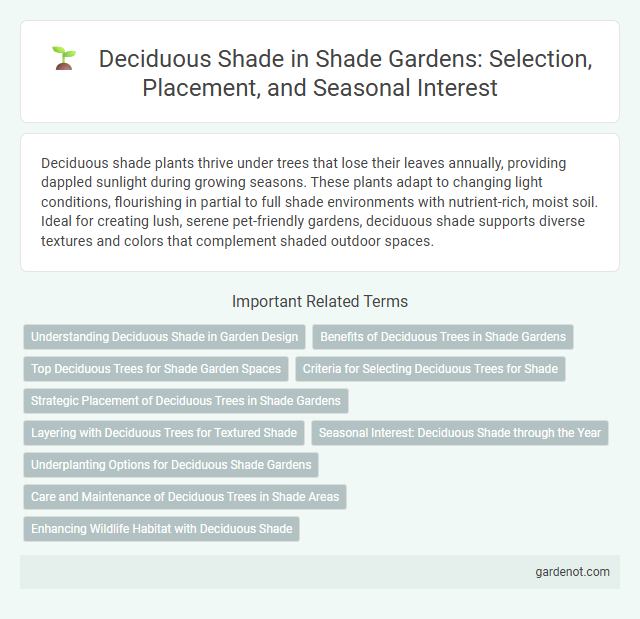Deciduous shade plants thrive under trees that lose their leaves annually, providing dappled sunlight during growing seasons. These plants adapt to changing light conditions, flourishing in partial to full shade environments with nutrient-rich, moist soil. Ideal for creating lush, serene pet-friendly gardens, deciduous shade supports diverse textures and colors that complement shaded outdoor spaces.
Understanding Deciduous Shade in Garden Design
Deciduous shade in garden design provides seasonal variation by allowing sunlight through in winter and creating cool, shaded areas in summer, enhancing plant diversity and energy efficiency. Trees such as maples, oaks, and birches are popular for their broad canopies and vibrant fall foliage, contributing to aesthetic appeal and microclimate regulation. Incorporating deciduous shade supports understory plants requiring partial sunlight and promotes sustainable landscaping through natural temperature control.
Benefits of Deciduous Trees in Shade Gardens
Deciduous trees in shade gardens provide seasonal light modulation by allowing sunlight to filter through their leaves in spring and summer while dropping them in autumn to increase winter sunlight exposure. They enhance soil quality through natural leaf litter decomposition, enriching the garden bed with organic matter that supports plant health. Their dynamic canopy structure creates a diverse microhabitat, promoting biodiversity and improving air circulation in shaded environments.
Top Deciduous Trees for Shade Garden Spaces
Top deciduous trees for shade garden spaces include species like Sugar Maple (Acer saccharum), Red Maple (Acer rubrum), and American Beech (Fagus grandifolia), known for their broad canopies and vibrant fall foliage. These trees provide ample shade coverage, moderate soil moisture, and enhance garden biodiversity by supporting local wildlife. Selecting native deciduous varieties optimizes growth and sustainability in temperate climates, making them ideal for creating inviting and shaded garden environments.
Criteria for Selecting Deciduous Trees for Shade
Deciduous trees ideal for shade gardens are selected based on canopy density, growth rate, and mature height to ensure optimal shade coverage and manageability. Soil adaptability, drought tolerance, and resistance to local pests enhance long-term survival and reduce maintenance needs. Seasonal leaf drop and root system behavior are considered to prevent damage to structures and maintain garden aesthetics.
Strategic Placement of Deciduous Trees in Shade Gardens
Strategic placement of deciduous trees in shade gardens maximizes seasonal sunlight exposure, allowing understory plants to thrive during winter months when trees shed leaves. Positioning these trees on the south or west side provides optimal light penetration, enhancing photosynthesis for shade-tolerant perennials. Proper spacing also ensures adequate airflow and reduces competition for nutrients, promoting a balanced and healthy garden ecosystem.
Layering with Deciduous Trees for Textured Shade
Layering with deciduous trees creates dynamic shade patterns that change seasonally, enhancing garden texture and depth. Combining canopy trees like maples with understory species such as dogwoods establishes a multi-dimensional shade environment. This stratified approach supports diverse plant growth and promotes ecological balance in shade gardens.
Seasonal Interest: Deciduous Shade through the Year
Deciduous shade trees provide dynamic seasonal interest by transforming garden environments throughout the year, offering vibrant foliage colors in autumn, lush green canopies in summer, and intricate branch patterns in winter. Their seasonal leaf drop enhances soil health and light penetration, promoting understory plant growth during colder months. This cyclical change contributes to biodiversity and creates varied microhabitats within a shade garden, supporting a range of wildlife species year-round.
Underplanting Options for Deciduous Shade Gardens
Underplanting options for deciduous shade gardens include shade-tolerant perennials such as hostas, ferns, and astilbes that thrive beneath the dappled light of tree canopies. Spring ephemerals like trilliums and bloodroot capitalize on early-season sunlight before the canopy fills in. Incorporating native wildflowers and groundcovers like sweet woodruff enhances biodiversity and soil health while providing seasonal interest.
Care and Maintenance of Deciduous Trees in Shade Areas
Deciduous trees in shade areas require careful attention to watering, especially during dry periods, to prevent stress and maintain healthy foliage. Pruning dead or overcrowded branches in late winter or early spring enhances air circulation and light penetration, promoting vigorous growth and disease resistance. Applying mulch helps regulate soil temperature and moisture, reducing competition from weeds and supporting root development in shaded garden conditions.
Enhancing Wildlife Habitat with Deciduous Shade
Deciduous shade trees create a dynamic wildlife habitat by providing seasonal shelter and diverse food sources for birds, insects, and small mammals. Their broad canopies offer nesting sites and protection during spring and summer, while fallen leaves enrich the soil with nutrients, supporting beneficial microorganisms and invertebrates. Incorporating native deciduous species like oak, maple, and birch maximizes ecological benefits and fosters biodiversity in shade gardens.
Deciduous shade Infographic

 gardenot.com
gardenot.com